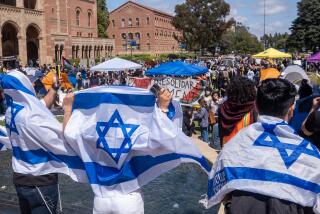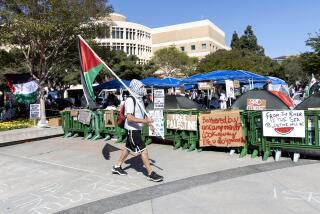Apartheid Sparks Student Activism : But Protesters Say Issue, Style Differ From the Turbulent ‘60s
- Share via
BERKELEY — The familiar signs are all there--rallies and marches, sit-ins and teach-ins, Simon and Garfunkel.
But the students protesting apartheid at the University of California here are not clones of their radical older brothers and sisters in the 1960s.
For one thing, their hero is not Che Guevara or any other violent revolutionary. If they look to any historical figure for inspiration, it is Dr. Martin Luther King, a champion of nonviolence and moral righteousness.
For another, the demonstrators are trying to form a more broad-based organization than the anti-war protesters of the 1960s. Blacks and whites share leadership jobs; women as well as men run meetings and set policy.
For the most part, though, it is difficult to categorize the new student activists--there are as many business students as sociology students; as many first-time protesters as veteran picketers.
Individually, they are hard put to explain the renewed activism among students here and at campuses across the nation. But interviews with demonstrators both on the steps of Sproul Hall and in protest headquarters nearby do show why, after a decade of relative political apathy, students once again decided to take their politics to the streets.
Apartheid--South Africa’s system of racial segregation and discrimination against its black majority--provided the right issue, they agreed, because it is a clear-cut moral issue. It also is an issue they believe affects them and one that they feel they can affect in return.
No ‘Other Side’ to Apartheid
“It’s not like the nuclear (build-up) issue, where there is always another side of the issue,” said Leslie, 22, an environmental studies student who recently dropped out and asked that her last name not be used. “There is no ‘other side’ to apartheid. Nobody can say they are for it.”
Protests have a sense of urgency, they said, because South African blacks themselves are rising against the system--walking off their jobs, boycotting school and massing against police. In the process, dozens of black people there have been shot to death by authorities.
Students said they also are motivated by South African Bishop Desmond Tutu, who won the 1984 Nobel Peace Prize for his anti-apartheid work, by protests at the South African Embassy in Washington, and by San Francisco dockworkers, who refused to handle South African cargo for a month last year.
Together, students said, these elements combined to help them shake off the political lethargy of the mid- to late-1970s and act.
“The 1970s were politically blah,” said Serena Herr, 21, a political science student. “You saw a lot of pathetic marches and pathetic rallies and pathetic protests, and it was very daunting. It was difficult to feel you could make a difference.”
Exposure of government excesses and failures in the early 1970s added to the sense of political impotence, the students said.
“For a long time, there was this cynicism about political activism,” said Harry Li, a 21-year-old art student. “I grew up with Watergate, and that gave me a feeling that politics was dirty and was best avoided.”
That began to change, they said, when President Reagan began to build up the military at the expense of many social programs.
“Without Ronald Reagan, this never would have happened,” said one student as he surveyed the bustle of political discourse and dissent swirling around him on the steps of Sproul Hall.
Others nearby agreed. The President’s “right-wing” policies, they said, and the nation’s conservative political drift set the stage for a “backlash” among students.
When riots in South Africa made the news last year, apartheid rallies again began attracting crowds. Then UC students, encouraged by protests at Columbia University, started a sit-in April 10 and the crowds at Berkeley grew larger still.
“The rallies just got bigger and bigger,” said Tony Lent, a 23-year-old sociology student who dropped out of his classes this semester to concentrate on the apartheid protests. “People were drawn by the magnetism of it all.”
‘Pent-Up Frustration’
“It released a lot of pent-up frustration,” Herr said. “It is an easy issue to understand and act on: We have money in the (South African) system; that is wrong; get it out. It’s clear. It’s simple.”
Others said the nature of the apartheid issue made it easy for students to turn their concern into action.
“Because it’s a clear moral issue,” said Billy Nessen, a 28-year-old Yale dropout, baker and self-described community activist, “it’s not so outrageous to join a sit-in and be arrested.”
Several people said they joined the protest after they saw it was having an effect.
“It is amazing to be part of a movement that is actually moving,” said Leslie, the woman who asked that her last name not be used. “I’ve seen so many that never got anywhere.
“That’s what makes this one so powerful. We can feel ourselves pushing the university back, every day. They come down and say, ‘You can’t do that,’ and we do it anyway. People are seeing we can win if we unite.”
University Hasn’t Acted
(The university has not taken up the students’ major demand--the complete and immediate sale of $2.4 billion worth of investments in 36 companies that do business in South Africa. Nor have university officials agreed with demands to vote on the matter this month or drop charges against all of the more than 300 demonstrators arrested since April 16.
(But the university did hold a public forum on divestiture, as protesters requested, and 13 of the 28 regents attended. UC President David P. Gardner also has added a divestiture discussion to the May regents meeting.)
Despite their unity in opposition to apartheid, protesters are split about drawing parallels between their demonstration and the Free Speech Movement and anti-war protests of the 1960s. A few welcome the comparison; most consider it irrelevant.
“We’re standing on the shoulders of the people of the ‘60s,” Nessen said. “We have learned a lot from that time.”
“We’ve been maligned,” countered Lent. “We’ve been painted as the ‘60s reincarnated, and we’re not. This is a new era.”
“I don’t think I would have been comfortable in the ‘60s,” Herr said. “I see that time as incredibly naive, incredibly violent and incredibly sexist. This is completely different.”
Some Similarities
There are some similarities between the new demonstrations and the protests of the ‘60s, but there also are some distinct differences--the current demonstrators’ preference for nonviolence, their concern about sexism and the intentional lack of formal leaders.
Nonviolence, however, has not precluded noncooperation. Demonstrators have ignored repeated requests to clear the steps in front of Sproul and to remove posters taped to the administration building. Protesters have also surrounded a police car to prevent a colleague from being taken to jail.
Decisions on these and other matters have been made jointly both by black and Asian students, who launched the current anti-apartheid campaign a year ago, and by the white students who have given the movement its numbers.
In addition, women fill many of the movement’s executive jobs and do much of the talking to university officials, police and reporters.
“There is still a lot of sexism,” Nessen said, “but women aren’t letting men get away with it, and a lot of men aren’t letting people get away with it either.”
Core Group of 150
Although there is a clear core of 150 or so people who camp out every night and a couple of dozen who organize and coordinate demonstrations, there are no clear leaders.
Protesters are careful to make all of their decisions by consensus--usually after long and often tedious hours of discussion on the Sproul steps--and then elect a representative to present each decision to authorities.
“It’s a sit-in,” Lent said. “It began that way and there were consensual decisions from the start. It seems kind of wrong to have leaders.”
Although they acknowledge that administrators find their system frustrating because it makes negotiations very difficult, the demonstrators agreed that the overall effect has been to cool their more quick-tempered colleagues and ensure that their democratic ideals are upheld.
They are keen to make clear they are not, in general, fundamentally opposed to the university or to the United States, only to some UC and U.S. policies. Lent, like several others, worried that some of his more strident remarks would make people “see us as a bunch of revolutionaries or leftists.”
“We’ve had to put up with a lot of that,” Herr said. “You know, that we are leftists or ‘60s leftovers or just out for fun.”
Optimistic About Outcome
Demonstrators are sure that the university will meet the divestiture demand--if not this year, then next. They are already lining up volunteers to continue demonstrations during the summer, and to escalate them next fall if necessary.
If the divestiture issue is settled by then, student organizers said they will simply shift their newly rekindled activism to other political issues.
“This thing will come in waves,” Nessen said of the demonstration. “If we’re mature enough, we will realize we can’t keep going up, up, up with it. We’ll press ahead, relax; press ahead, relax; press ahead, relax. Until we win.
“Then, when we move on to other things--like the Livermore lab (a nuclear-weapons facility run by the university) and Central America--we can look back on this and draw strength.”
More to Read
Sign up for Essential California
The most important California stories and recommendations in your inbox every morning.
You may occasionally receive promotional content from the Los Angeles Times.










